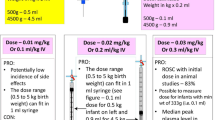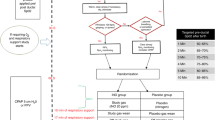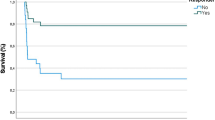Abstract
Objective:
Infants with transient tachypnea of the newborn (TTN) have relatively low levels of epinephrine, which is known to mediate fetal lung fluid absorption. Providing exogenous epinephrine could be a valuable diagnostic and therapeutic intervention for this common condition. Our primary objective was to determine if inhaled racemic epinephrine is safe for the treatment of TTN. Our secondary objective was to determine its efficacy.
Study Design:
We conducted a randomized, blinded, placebo-controlled pilot trial. Inhaled racemic epinephrine or placebo was administered to 20 newborns with TTN. Physiologic variables of cardiopulmonary function were measured during and after treatment.
Result:
No infant in either the treatment or control arm experienced an adverse event, including tachycardia or hypertension. We did not detect a difference between the two groups regarding rate of resolution of tachypnea.
Conclusion:
We did not observe any adverse effects of inhaled racemic epinephrine when administered for the treatment of TTN. Larger studies are necessary to determine efficacy.
This is a preview of subscription content, access via your institution
Access options
Subscribe to this journal
Receive 12 print issues and online access
$259.00 per year
only $21.58 per issue
Buy this article
- Purchase on Springer Link
- Instant access to full article PDF
Prices may be subject to local taxes which are calculated during checkout



Similar content being viewed by others
References
Clark RH . The epidemiology of respiratory failure in neonates born at an estimated gestational age of 34 weeks or more. J Perinatol 2005; 25(4): 251–257.
Rubaltelli FF, Bonafe L, Tangucci M, Spagnolo A, Dani C . Epidemiology of neonatal acute respiratory disorders. A multicenter study on incidence and fatality rates of neonatal acute respiratory disorders according to gestational age, maternal age, pregnancy complications and type of delivery. Italian group of neonatal pneumology. Biol Neonate 1998; 74(1): 7–15.
Kumar A, Bhat BV . Epidemiology of respiratory distress of newborns. Indian J Pediatr 1996; 63(1): 93–98.
Morrison JJ, Rennie JM, Milton PJ . Neonatal respiratory morbidity and mode of delivery at term: influence of timing of elective caesarean section. Br J Obstet Gynaecol 1995; 102(2): 101–106.
Agrawal V, David RJ, Harris VJ . Classification of acute respiratory disorders of all newborns in a tertiary care center. J Natl Med Assoc 2003; 95(7): 585–595.
Patel DM, Donovan EF, Keenan WJ . Transient respiratory difficulty following cesarian delivery. Biol Neonate 1983; 43(3–4): 146–151.
Hales KA, Morgan MA, Thurnau GR . Influence of labor and route of delivery on the frequency of respiratory morbidity in term neonates. Int J Gynaecol Obstet 1993; 43(1): 35–40.
Levine EM, Ghai V, Barton JJ, Strom CM . Mode of delivery and risk of respiratory diseases in newborns. Obstet Gynecol 2001; 97(3): 439–442.
Hook B, Kiwi R, Amini SB, Fanaroff A, Hack M . Neonatal morbidity after elective repeat cesarean section and trial of labor. Pediatrics 1997; 100(3 Part 1): 348–353.
Yang JY, Fang LJ, Tsou Yau KI . Labor pain before elective cesarean section reduces neonatal respiratory distress. Zhonghua Min Guo Xiao Er Ke Yi Xue Hui Za Zhi 1997; 38(1): 38–43.
Cohen M, Carson BS . Respiratory morbidity benefit of awaiting onset of labor after elective cesarean section. Obstet Gynecol 1985; 65(6): 818–824.
Gowen Jr CW, Lawson EE, Gingras J, Boucher RC, Gatzy JT, Knowles MR . Electrical potential difference and ion transport across nasal epithelium of term neonates: correlation with mode of delivery, transient tachypnea of the newborn, and respiratory rate. J Pediatr 1988; 113(1 Part 1): 121–127.
Avery ME, Gatewood OB, Brumley G . Transient tachypnea of newborn. Possible delayed resorption of fluid at birth. Am J Dis Child 1966; 111(4): 380–385.
Haney PJ, Bohlman M, Sun CC . Radiographic findings in neonatal pneumonia. AJR Am J Roentgenol 1984; 143(1): 23–26.
Heritage CK, Cunningham MD . Association of elective repeat cesarean delivery and persistent pulmonary hypertension of the newborn. Am J Obstet Gynecol 1985; 152(6 Part 1): 627–629.
Bucciarelli RL, Egan EA, Gessner IH, Eitzman DV . Persistence of fetal cardiopulmonary circulation: one manifestation of transient tachypnea of the newborn. Pediatrics 1976; 58(2): 192–197.
Cloherty J, Eichenwald EC, Stark AR . Manual of Neonatal Care, 5th edn. Lippincott Williams & Wilkins: Philadelphia, 2004.
Tudehope DI, Smyth MH . Is ‘transient tachypnoea of the newborn’ always a benign disease? Report of 6 babies requiring mechanical ventilation. Aust Paediatr J 1979; 15(3): 160–165.
Hack M, Fanaroff AA, Klaus MH, Mendelawitz BD, Merkatz IR . Neonatal respiratory distress following elective delivery. A preventable disease? Am J Obstet Gynecol 1976; 126(1): 43–47.
Barker PM, Olver RE . Invited review: clearance of lung liquid during the perinatal period. J Appl Physiol 2002; 93(4): 1542–1548.
Jain L, Eaton DC . Physiology of fetal lung fluid clearance and the effect of labor. Semin Perinatol 2006; 30(1): 34–43.
Richardson BS, Czikk MJ, daSilva O, Natale R . The impact of labor at term on measures of neonatal outcome. Am J Obstet Gynecol 2005; 192(1): 219–226.
Zanardo V, Simbi AK, Franzoi M, Solda G, Salvadori A, Trevisanuto D . Neonatal respiratory morbidity risk and mode of delivery at term: influence of timing of elective caesarean delivery. Acta Paediatr 2004; 93(5): 643–647.
Nielsen TF, Hokegard KH . The incidence of acute neonatal respiratory disorders in relation to mode of delivery. Acta Obstet Gynecol Scand 1984; 63(2): 109–114.
Irestedt L, Lagercrantz H, Hjemdahl P, Hagnevik K, Belfrage P . Fetal and maternal plasma catecholamine levels at elective cesarean section under general or epidural anesthesia versus vaginal delivery. Am J Obstet Gynecol 1982; 142(8): 1004–1010.
Greenough A, Lagercrantz H . Catecholamine abnormalities in transient tachypnoea of the premature newborn. J Perinat Med 1992; 20(3): 223–226.
Brown MJ, Olver RE, Ramsden CA, Strang LB, Walters DV . Effects of adrenaline and of spontaneous labour on the secretion and absorption of lung liquid in the fetal lamb. J Physiol 1983; 344: 137–152.
Lawson EE, Brown ER, Torday JS, Madansky DL, Taeusch Jr HW . The effect of epinephrine on tracheal fluid flow and surfactant efflux in fetal sheep. Am Rev Respir Dis 1978; 118(6): 1023–1026.
Walters DV, Olver RE . The role of catecholamines in lung liquid absorption at birth. Pediatr Res 1978; 12(3): 239–242.
Strang LB . Solute and water transport across the pulmonary epithelium: a new chapter in lung physiology inaugurated by Alfred Jost. Biol Neonate 1989; 55(6): 355–365.
Davies MW, Davis PG . Nebulized racemic epinephrine for extubation of newborn infants. Cochrane Database Syst Rev 2002; (1): CD000506.
Hartling L, Wiebe N, Russell K, Patel H, Klassen T . Epinephrine for bronchiolitis. Cochrane Database of Systematic Reviews 2004.
Nephron Pharmaceuticals Corporation. [cited 7/27/07]; available from http://www.nephronpharm.com/.
Cabero L, Giralt E, Navarro E, Calaf J, Cabero A, Duran-Sanchez P et al. A betamimetic drug and human fetal lung maturation. Eur J Obstet, Gynecol Reprod Biol 1979; 9(4): 261–263.
Sperling MA, Ganguli S, Leslie N, Landt K . Fetal-perinatal catecholamine secretion: role in perinatal glucose homeostasis. Am J Physiol 1984; 247(1 Part 1): E69–E74.
Acknowledgements
Biostatistical analysis was performed by Peter Forbes Clinical Research Program, Children's Hospital, Boston MA, USA. This work was funded by Nephron Pharmaceuticals.
Author information
Authors and Affiliations
Corresponding author
Rights and permissions
About this article
Cite this article
Kao, B., Stewart de Ramirez, S., Belfort, M. et al. Inhaled epinephrine for the treatment of transient tachypnea of the newborn. J Perinatol 28, 205–210 (2008). https://doi.org/10.1038/sj.jp.7211917
Received:
Revised:
Accepted:
Published:
Issue Date:
DOI: https://doi.org/10.1038/sj.jp.7211917
Keywords
This article is cited by
-
Recent Advances in Pathophysiology and Management of Transient Tachypnea of Newborn
Journal of Perinatology (2021)
-
Evaluation of inhaled beta-2 agonist in management of transient tachypnea of the newborn
Bulletin of the National Research Centre (2020)



